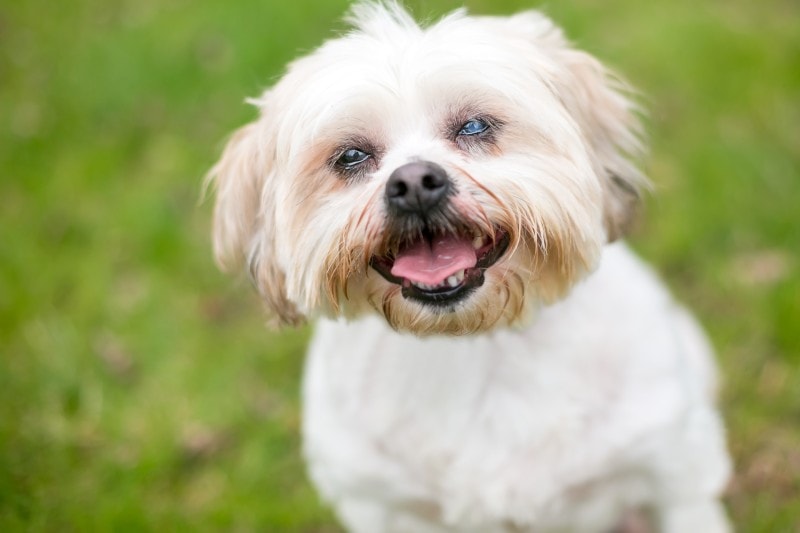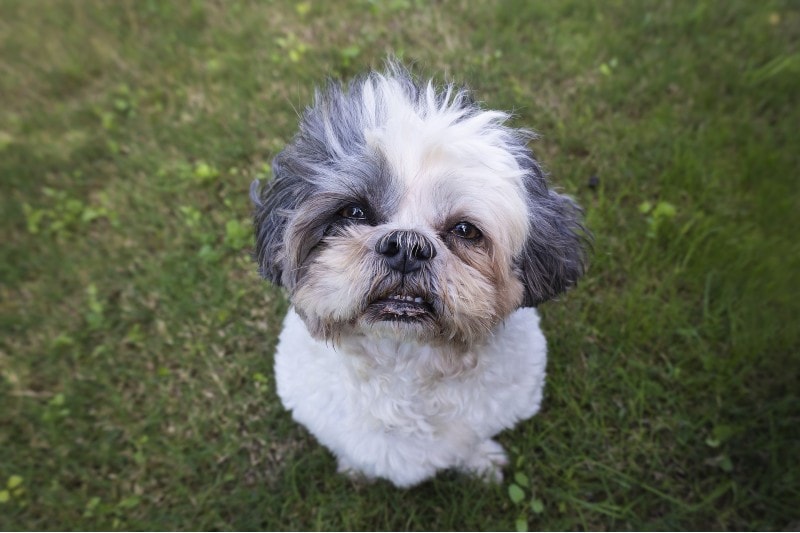Shih Tzus are very popular family dogs thanks to their fun-loving, spirited, and affectionate natures. They bring a lot of joy and countless laughs to any household they’re a part of for many years (their long-expected lifespans of 10–18 years are a bonus).
Nevertheless, if you’re a Shih Tzu parent or are considering making one a member of your family, there are some health issues this breed is prone to that you should be aware of. In this post, we’ll explore 12 health conditions to keep an eye out for if you have a Shih Tzu.
The 12 Common Health Problems in Shih Tzus
1. Brachycephalic Obstructive Airway Syndrome
Because Shih Tzus have short faces, they are a brachycephalic breed, along with Pugs, French Bulldogs, and others. Unfortunately, brachycephalic dogs are prone to breathing problems and symptoms of severe cases include a loud, pronounced noise in the airways, getting tired quickly, collapsing or fainting after exercise, retching, coughing, gagging, and vomiting.
Brachycephalic dogs tend to struggle in hot and humid weather due to being more at risk of overheating. In the long term, the extra effort Brachycephalic breeds have to make just to breathe can result in the heart struggling to keep up with the demands.
If you have a brachycephalic breed, it’s important to manage things by keeping your dog out of hot, humid temperatures, keeping them at a healthy weight, and making their environment as stress-free as possible. In some cases, a vet may recommend surgery to help your dog breathe more easily.

2. Collapsing Trachea
When the cartilage rings in the windpipe weaken and flatten down when the dog breathes in, this is what’s known as a collapsing trachea. Shih Tzus are one of the most commonly affected breeds, along with Chihuahuas and Toy Poodles among others.
Symptoms include a dry cough that’s persistent in nature and sounds somewhat like a “goose honk.” When pressure is applied to the neck, the coughing may get worse. This condition is treated with surgery and/or medication.
3. Hip Dysplasia
Hip dysplasia is a condition that causes the hip ball and socket to loosen because they did not grow at an equal rate during the growth stage. This results in discomfort and pain and leads to degenerative joint disease and/or arthritis. Treatment includes managing the condition at home with moderate exercise and weight control, medication, vet-prescribed supplements for the joints, physical therapy, and, in some cases, surgery.
4. Luxating Patella
This term is used to describe a dislocated kneecap. Unfortunately, several small and toy breeds are susceptible to a luxating patella1, including the Shih Tzu, Maltese, and Bichon Frise. There are four grades, the highest grade being the most serious. Treatment options depend on how severe the luxation is—grades two to four are often treated with surgery.

5. Corneal Damage
Shih Tzus are susceptible to corneal damage and eye ulceration caused by dry eye and entropion. Dogs with dry eyes suffer from inflammation in the cornea and areas surrounding it because there’s too much dryness. Entropion is a condition that causes the eyelids to roll inwards.
Watch out for symptoms like irritated eyes that are red, sore, squinting, and/or held shut (dry eye). Symptoms of entropion include squinting, excessive tearing, discharge, and holding the eye shut.
6. Proptosis
Proptosis is a medical emergency. Dogs with proptosis suffer from a dislodged eyeball that pops out of the socket. In severe cases, the eyeball can completely detach and result in loss of vision. It usually happens as the result of an injury and requires swift medical attention, so call a vet right away if you suspect proptosis.
7. Cataracts
When the eye lens becomes cloudy or opaque, this is what’s called a cataract. If the lens becomes 100% opaque, it causes blindness, though this does not happen in every case. Dogs with a smaller percentage of opacity (up to 30%) are much less likely to suffer from problems with vision. Fortunately, treatment options are available to prevent blindness.

8. Progressive Retinal Atrophy
Progressive retinal atrophy is a condition in which the photoreceptor cells in the retina start to deteriorate, which, in the long term, results in blindness. One of the early symptoms is night blindness, which means your dog may bump into things when it’s dark and struggle to find their way around. There is no treatment for progressive retinal atrophy, but blindness in dogs can be managed to improve their quality of life.
9. Cushing’s Disease
Cushing’s disease affects the adrenal glands, causing them to produce too much cortisol (the stress hormone). It can be caused by tumors or the long-term use of steroids. Symptoms include drinking more water, appetite increase, lethargy, unkempt coat condition, and peeing more often than usual.
Treatment involves treating the tumors causing the condition with either medication or surgery and controlled discontinuation of steroids if this is the cause. Please always follow your vet’s advice on how to do this.
10. Hypothyroidism
When the thyroid gland doesn’t produce enough of a certain hormone, it causes the metabolism to slow down—this is what is known as hypothyroidism.
Symptoms include weight gain, lethargy, unwillingness to exercise, an unkept coat that sheds a lot, and being intolerant to the cold among other symptoms. It is treated with a replacement hormone that must be administered for the remainder of the dog’s life.

11. Portosystemic Shunt
This is a liver disorder in which blood shunts around the liver due to the portal vein (the vein that carries blood into the liver) and another vein not connecting properly. Symptoms include, but are not limited to, disorientation, seizures, head pressing, circling, stunted growth, and poor muscle development.
The condition is usually managed with medication and special diets, though further treatment may be required for dogs with severe cases.
12. Intervertebral Disc Disease
When the discs in a dog’s spine slip, rupture, herniate, or bulge out, this is what’s known as intervertebral disc disease. It’s a progressive disease that worsens with time and can be hard to diagnose until it is in the late stages.
It affects the neck and back and signs include holding the head low, hind leg weakness, unwillingness to move, unsteadiness, and struggling to stand or walk properly depending on which part of the spinal cord is affected. This condition is treated with physical therapy, surgery, or anti-inflammatory medications.
- Eye injury (due to large, bulging eyes)
- Ear infections
- Allergies
Conclusion
To increase the chances of your Shih Tzu staying healthy, it’s a good idea to take them for at least one vet checkup per year even if they seem fine, though it’s perfectly fine to bring them more if you want to put your mind at ease.
Check your Shih Tzus eyes often for signs of redness, swelling, and/or opacity, and their ears for dirt, inflammation, discharge, or anything that seems unusual to you. Keep an eye out for other symptoms of being unwell and make sure your Shih Tzu is eating a high-quality diet and being exercised enough. If you suspect that something isn’t right, please contact your vet.
Featured Image Credit: Fran • @thisisfranpatel, Pixabay
Contents
- The 12 Common Health Problems in Shih Tzus
- 1. Brachycephalic Obstructive Airway Syndrome
- 2. Collapsing Trachea
- 3. Hip Dysplasia
- 4. Luxating Patella
- 5. Corneal Damage
- 6. Proptosis
- 7. Cataracts
- 8. Progressive Retinal Atrophy
- 9. Cushing’s Disease
- 10. Hypothyroidism
- 11. Portosystemic Shunt
- 12. Intervertebral Disc Disease
- Conclusion










